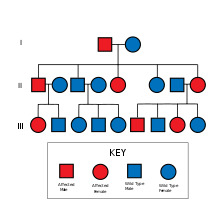Heteroĥromio

Heteroĥromio signifas, ke la du okuloj de homo aŭ besto havas malsamajn kolorojn. Plej ofte ĝi estas hereda, sed ĝi ankaŭ povas estiĝi post traŭmatoj aŭ malsanoj.[1][2]
Tipoj
[redakti | redakti fonton]
Tiu rara mutado havas multajn specojn. Ĝi povas esti parta aŭ plena. Se ĝi estas plena, la du okulo havas diversajn kolorojn, ekzemple la unu estas blua, la alia bruna. Se ĝi estas parta, ankaŭ unu okulo estas dukolora, ekzemple centre estas bruna, ekstere blua. La vera koloro de okulo estas la ekstera.
Kialoj
[redakti | redakti fonton]Plej ofte ĝi estas hereda, sed ĝi ankaŭ povas okazi per genetika mozaiko aŭ ĥimerio.[2] Pli rare okazigas ĝin iu malsano, kiel glaŭkomo, itoj, neurofibrimatoso, aŭ sindromo de Waardenburg; drogoj; lezioj, kiel fremda korpo, aŭ ensangado.
Bestoj
[redakti | redakti fonton]Ĉe hejmbestoj estas la heteroĥromio pli ofta. Tie kaze plej plie unu okulo estas blua, kaj ĝia ĉirkaŭaĵo blanka. La katoj estas pleje plene blankaj, kaj la alia okulo estas flava, oranĝa, verda aŭ kuprakolora. Ĝi estas plej pli ofta ĉe turkaj rasoj, ĉe Khao Manee katoj, aŭ ĉe japana bobtailo. Ĉe hundoj ĝi estas plej pli ofta ĉe siberia huskyo, ĉe catahoula leopardhundo, aŭ australa ŝafhundo. Ĉe ĉevaloj ĝi estas pli ofta ĉe pinto koloraj rasoj; unu okulo estas bruna, la alia griza, blua aŭ blanka. Oni trovis ankaŭ heteroĥromiajn bovojn kaj akvobubalojn.[3] Ankaŭ furoj kun sindromo de Waardenburg povas esti heteroĥromiaj.
La parta heteroĥromio estas plej pli ofta ĉe merlaharaj hundoj, kiuj estas precipe paŝtistohundoj, aŭ dunkero, germana dogo, melhundo, aŭ ĉivava hundo, sed pli rara ĝi estas trovebla ankaŭ ĉe aliaj rasoj.
Galerio
[redakti | redakti fonton]-
Parta heteroĥromio
-
Centrala heteroĥromio
-
Heteroĥromia siberia sledhundo
-
Heteroĥromia kato
-
Heteroĥromia katahula leopardhundo
Referencoj
[redakti | redakti fonton]- ↑ Mitől lehet különböző színű két szemünk?. Horizont Magazin. Arkivita el la originalo je 2015-09-19. Alirita 2015-08-13. Arkivita kopio. Arkivita el la originalo je 2015-09-19. Alirita 2015-09-06. hungare
- ↑ 2,0 2,1 Imesch PD, Wallow IH, Albert DM (február 1997). “The color of the human eye: a review of morphologic correlates and of some conditions that affect iridial pigmentation throughout life.”, Surv Ophthalmol. 41 (Suppl 2.), p. 117–123. doi:10.1016/S0039-6257(97)80018-5. angle
- ↑ Misk NA, Semieka MA, Fathy A (1998). “Heterochromia iridis in water buffaloes (Bubalus bubalis)”, Vet Ophthalmol. 1 (4), p. 195–201. doi:10.1046/j.1463-5224.1998.00036.x. angle
- La heteroĥromio, la bela mutado Arkivigite je 2015-09-23 per la retarkivo Wayback Machine (Sulinet) hungare
- Heterochromia Iridis en la databaso de Mendala heredigo en homo angle
Text is available under the CC BY-SA 4.0 license; additional terms may apply.
Images, videos and audio are available under their respective licenses.





